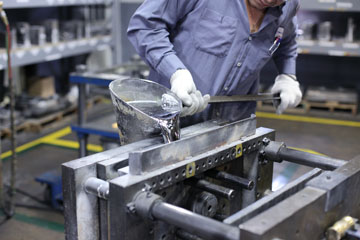 While you may know generally what it is and understand a little bit about the process, lead casting truly is both a science and an art. So we have decided to share with you our “Technical Dictionary of Lead Casting Terms.” We hope this will demonstrate the intricacy and the complexity of the lead casting process.
While you may know generally what it is and understand a little bit about the process, lead casting truly is both a science and an art. So we have decided to share with you our “Technical Dictionary of Lead Casting Terms.” We hope this will demonstrate the intricacy and the complexity of the lead casting process.
Technical Dictionary of Lead Casting Terms
Porosity: This term refers to the measurement of voids in a casting. Porosity is typically caused by air pockets in a casting where the wall is not 100 percent metal. There is no such thing as a porosity-free casting; but it can be controlled and limited. All castings have some level of porosity which can lead to radiation leaks in shielding products.
Cold Flow: This is a term that is used to describe when the metal solidifies to fast or in different segments causing cooling lines. The surface of a product will have lines in it and some of them could sink into the part. This is caused by not having the tool or metal hot enough or controlled enough to maintain temperature throughout the pour. Cold flow can lead to the wall not being consistent and radiation leaks in shielding products.
Sink Hole: This term is used to describe a void that forms between cold flow and porosity. It will appear like a hole in the metal. It is also the result of problems with temperature control. If there is not enough heat or if the heat is not maintained in the pouring process, sink holes can form in the metal.
Turbulence: Metal flows into a tool and each time the metal changes directions, it swirls causing turbulence. This swirling (turbulence) of the metal leads to porosity and the less turbulence there is, the better the casting. Turbulence also leads to freeze off (solidifying) which is where the metal swirls and touches the walls of the tooling and can begin freezing (solidifying). When this happens and molten metal flows around metal that is freezing, you get porosity pockets. Through tool design and metal flow, the goal is to reduce turbulence.
Gate: The fill area where molten metal is poured into a tool to create a part is called a gate. The gate is generally shaped like a cone to keep head pressure on the metal in the tool. This conical shape also allows molten metal to feed the shrink (see definition later in this post) on the metal. The gate is on top in a gravity casting, but in a die casting it can be in multiple locations. The gate is generally cut or machined off to yield the final shape of the part. By design, the gate usually contains more porosity so when it is removed, the porosity is also moved out of your finished part.
Riser: Air will get trapped inside the tool if you simply pour molten metal into it. Risers are used in specific locations inside a tool to allow air to escape and ensure metal flow through the tool. The channels on top of the tool allow air out as metal flows out of the main chamber into the riser. The risers allow better metal flow to reduce porosity in the finished part. They are cut or machined off in the final stages of production.
Runner: A runner is a channel that allows metal to flow through it. Runners are more common in die casting because they are the pathway where the metal flows into the tool and into the part cavity. In die castings, they are broken off or trimmed off at the end of the process. Runners can also be used in some gravity cast parts to aid in metal flow. They are typically used when multiple fill locations are necessary at one time.
Core: A core is a piece of the tool that makes the internal shape. If you consider a bottle as the finial part the core would produce the ID of the bottle while the rest of the tool generates the rest of the design. Tools are also called patterns and a core would insert into the tool and seat allowing the core to make the internal geometry.
Alloy: The alloy is the metal composition that is used in a casting. In lead casting, pure lead is used but alloys with antimony are more common such as 1%, 2%, 3%, 6% antimony (balance lead). The addition of antimony helps metal flow and adds strength to the metal.
Shrink: Metal shrinks when it cools from molten to solid. The metal will shrink onto cores and pull away from the walls of the tooling. In complex geometries, parts will shrink in multiple directions at once and can pull themselves apart. Shrink needs to be added in tooling design to yield products to the desired shape and tolerances.
Draft: Draft is the angle that is added to the part and in turn the tool which allows the part to be removed from the tooling. Without draft, parts would not be able to be extracted from the tooling.
Up Casting: The process in which metal is poured into the tool through the gate and then into a runner that goes to the bottom of the part and feeds into the bottom of the part geometry. This technique helps to reduce turbulence in the flow of metal into the chamber. It can be a good way to ensure a good pour based on the part’s geometry.

